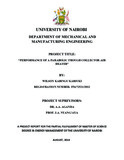| dc.description.abstract | A low cost parabolic trough concentrator (PTC) was built at the Mechanical Engineering workshop of the University of Nairobi. The PTC was built to heat air to temperatures of 1000C and above which cannot be attained by direct sunlight or by flat plate collectors. The trough was made of a standard galvanized sheet with two hard board end pieces. Aluminum foil was used as the reflective material and was glued on the inside of the trough on the galvanized sheet. The stand was made of 50.8 X 50.8 X 3mm square tubes. The receiver pipe was made of 1 inch (25.4mm) diameter galvanized water pipe. A manual tracking system was used to track the sun. The trough when assembled had a width of 1.077m, a length of 2.44m and a depth of 0.3m and a focal length of 0.25m. When the PTC was assembled with the stand, it had an overall height of 1.176m as shown in Drawing No. 007/PTC/2013 in Appendix 2. The PTC was tested between 1100hrs and 1500hrs standard time at the Mechanical Engineering workshop of the University of Nairobi. This was because it is during these hours that there is maximum solar radiation during a typical day. The minimum and the maximum air mass flow rates tested were 0.0006kg/s and 0.0078kg/s respectively. The results showed that the outlet air temperature followed closely the variation in solar radiation. The same was true with actual useful energy as it is a function of outlet air temperature. When the sky is clear, it was found that solar radiation values are fairly steady with little intermittence. During cloudy days, the solar radiation was found not to be steady but changes as the cloud cover appears and can get as low as 150W/m2.
Temperature rise was found to be higher with smaller air mass flow rates and reduces as the mass flow rates increases. However the useful energy obtained from the PTC was found to be lower with lower mass flow rates and higher with higher mass flow rates. This was also true with overall efficiency. The maximum outlet air temperature obtained from tests was 1820C with the least flow rate of 0.0006kg/s while the maximum overall efficiency was 27.7% with the maximum air flow rate tested of 0.0078kg/s. Data obtained from testing one trough was used to theoretically approximate the performance when two troughs were connected in series. It
v
was found that while outlet temperature, heat losses and useful energy increased, the overall efficiency and the receiver efficiency reduced. Covering the collector with glass led to a significant increase in outlet air temperature and thus the actual useful energy. This increase was between 0.0350C per W/m2 with a mass flow rate of 0.0006kg/s to 0.0190C per W/m2 with a mass flow rate of 0.0078kg/s. This study showed that a PTC has the ability to heat air to 1000C and above which has the potential to increase the drying rate of biomass. The PTC has the potential to be used for generating drying air in industries such as sugar industry for drying of bagasse, local authorities for drying of municipal solid waste and in tea industry | en_US |

